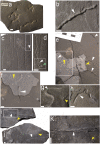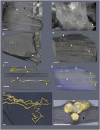Organism motility in an oxygenated shallow-marine environment 2.1 billion years ago
- PMID: 30808737
- PMCID: PMC6397584
- DOI: 10.1073/pnas.1815721116
Organism motility in an oxygenated shallow-marine environment 2.1 billion years ago
Abstract
Evidence for macroscopic life in the Paleoproterozoic Era comes from 1.8 billion-year-old (Ga) compression fossils [Han TM, Runnegar B (1992) Science 257:232-235; Knoll et al. (2006) Philos Trans R Soc Lond B 361:1023-1038], Stirling biota [Bengtson S et al. (2007) Paleobiology 33:351-381], and large colonial organisms exhibiting signs of coordinated growth from the 2.1-Ga Francevillian series, Gabon. Here we report on pyritized string-shaped structures from the Francevillian Basin. Combined microscopic, microtomographic, geochemical, and sedimentologic analyses provide evidence for biogenicity, and syngenicity and suggest that the structures underwent fossilization during early diagenesis close to the sediment-water interface. The string-shaped structures are up to 6 mm across and extend up to 170 mm through the strata. Morphological and 3D tomographic reconstructions suggest that the producer may have been a multicellular or syncytial organism able to migrate laterally and vertically to reach food resources. A possible modern analog is the aggregation of amoeboid cells into a migratory slug phase in cellular slime molds at times of starvation. This unique ecologic window established in an oxygenated, shallow-marine environment represents an exceptional record of the biosphere following the crucial changes that occurred in the atmosphere and ocean in the aftermath of the great oxidation event (GOE).
Keywords: Francevillian; Paleoproterozoic Era; motility; oxygenation.
Conflict of interest statement
The authors declare no conflict of interest.
Figures




References
-
- El Albani A, et al. Large colonial organisms with coordinated growth in oxygenated environments 2.1 Gyr ago. Nature. 2010;466:100–104. - PubMed
-
- Bros R, Stille P, Gauthier-Lafaye F, Weber F, Clauer N. Sm-Nd isotopic dating of Proterozoic clay material: An example from the Francevillian sedimentary series, Gabon. Earth Planet Sci Lett. 1992;113:207–218.
-
- Horie K, Hidaka H, Gauthier-Lafaye F. U-Pb geochronology and geochemistry of zircon from the Franceville series at Bidoudouma, Gabon. Geochim Cosmochim Acta. 2005;69:A11.
Publication types
MeSH terms
Substances
LinkOut - more resources
Full Text Sources
Research Materials

